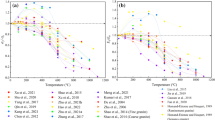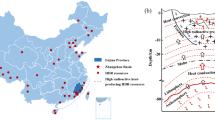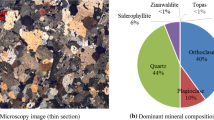Abstract
Numerical modeling is a promising way to understand the characteristics of the thermo-mechanical (TM) coupled behaviors in rocks under high-temperature impact. This paper documents the thermo-mechanical response of Eibenstock granite (EG) through laboratory experiments and numerical simulations using a proposed TM coupled Grain-Based Model (GBM). Uniaxial compression and Brazilian tests of EG specimens after 400 °C and 600 °C heating–cooling cycles were undertaken. Based on the laboratory results, a newly developed TM coupled contact constitutive law considers mineral composition, heterogeneous temperature-dependent properties, reversible α ↔ β quartz-transitions, crack-slipping displacements with strength reduction, and real-time crack evolution. The models can well reproduce the real-time thermal expansion–contraction, microstructural changes, nonlinear stress–strain behavior, temperature-dependent strength, and the ultimate failure modes of thermal-damaged specimens. The P-wave velocities and the simulated thermal cracking revealed that the material contraction during cooling leads to a width reduction of the earlier heating-formed cracks. Newly induced microcracks are rare during cooling due to the released stress concentrations of the local mineral grains. The residual thermal strain, which results from microcrack formation and the growth of pre-existing microcracks, was simulated and used as a quantitative index of thermally induced damages. The damage degree of the 600 °C samples was up to six times higher than that of the 400 °C, leading to a stronger strength reduction upon mechanical loading and a higher concave stress–strain nonlinearity caused by micro-crack closing at the beginning of loading. In general, the GBM is able to simulate the TM coupled behavior of polycrystalline rocks in a realistic manner.
Highlights
-
A joint constitutive law considering both temperature and crack-slipping is proposed.
-
TM models considering a heating-cooling cycle are calibrated by laboratory tests.
-
Real-time thermal-induced strains of granite specimens are reproduced.
-
Concave stress-strain nonlinearity of thermally damaged granites is replicated.










Similar content being viewed by others
Availability of Data and Materials
Not applicable.
Code Availability
Not applicable.
Abbreviations
- A c :
-
Area of the contact
- B :
-
Thickness of the Brazilian disc
- C p :
-
Specific heat
- D :
-
Diameter of the Brazilian disc
- E m :
-
Micro-Young’s modulus
- F max :
-
Maximum load
- F s :
-
Shear force magnitude
- F i s :
-
Shear force vector
- F n :
-
Normal force
- K :
-
Bulk modulus
- M :
-
Mass
- Q i :
-
Heat flux in the positive i-direction
- Q net :
-
Net heat flow
- S max :
-
Maximum shear force
- S res :
-
Residual shear force
- S temp-max :
-
Maximum shear force depending on temperature
- \(S_{{{\text{temp}} - {\text{res}}}}^{{{\text{disp}}}}\) :
-
Residual maximum shear force considering contact slipping displacement and temperature
- T max :
-
Maximum tensile normal force
- T res :
-
Residual tensile normal force
- T temp-max :
-
Maximum tensile normal force dependent on temperature
- c m :
-
Micro-cohesion
- c 0 :
-
Initial cohesion before heat treatment
- c temp :
-
Temperature-dependent cohesion
- c res :
-
Residual cohesion
- \(c_{{{\text{res}}}}^{{{\text{disp}}}}\) :
-
Residual cohesion depending on contact slipping displacement
- \(c_{{{\text{temp}} - {\text{res}}}}^{{{\text{disp}}}}\) :
-
Residual cohesion depending on contact slipping displacement and temperature
- \(f_{{{\text{res}} - c}}^{{{\text{disp}}}}\) :
-
Slip-weakening function of residual cohesion depending on contact slipping displacement
- \(f_{{{\text{res}} - \varphi }}^{{{\text{disp}}}}\) :
-
Slip-weakening function of residual friction angle depending on contact slipping displacement
- f temp -c :
-
Temperature-strengthening functions of cohesion
- f temp -φ :
-
Temperature-strengthening functions of friction angle
- f temp -t :
-
Temperature-strengthening functions of tensile strength
- h sample :
-
Height of the sample
- k :
-
Thermal conductivity
- k n :
-
Contact normal stiffness
- k s :
-
Contact shear stiffness
- k ij :
-
Thermal conductivity tensor
- t step :
-
Mechanical timestep
- t model :
-
Model time
- v y :
-
Mechanical loading velocity
- v step :
-
Steps per second
- α t :
-
Coefficient of linear thermal expansion for specific temperature
- ε c :
-
Failure strain
- δ ij :
-
Kronecker delta
- σ t :
-
Tensile stress
- σ temp -t :
-
Temperature-dependent tensile strength
- ρ m :
-
Micro-density
- ρ :
-
Mass density
- ν m :
-
Micro-Poisson’s ratio
- φ m :
-
Micro-friction angle
- φ temp :
-
Temperature-dependent friction angle
- \(\varphi_{{{\text{res}}}}^{{{\text{disp}}}}\) :
-
Residual friction angle depending on contact slipping displacement
- \(\varphi_{{{\text{temp}} - {\text{res}}}}^{{{\text{disp}}}}\) :
-
Residual friction angle depending on contact slipping displacement and temperature
- ∆F n :
-
Normal force increment
- ∆F i s :
-
Shear force vector increment
- ∆h:
-
Height increment
- ∆u n :
-
Normal displacement increment
- ∆u i s :
-
Shear displacement vector increment
- ΔT :
-
Temperature increment
- ∆z min :
-
Smallest width of an adjoining zone
- ∆σ ij :
-
Stress increment
- ∆ε ij :
-
Strain increment
- ∂T/∂x j :
-
Temperature gradient
References
Baldo JB, dos Santos WN (2002) Phase transitions and their effects on the thermal diffusivity behaviour of some SiO2 polymorphs. Cerâmica 48:172–177. https://doi.org/10.1590/S0366-69132002000300011
Ezzein FM, Bathurst RJ (2011) A transparent sand for geotechnical laboratory modeling. Geotech Test J. https://doi.org/10.1520/GTJ103808
Farahmand K, Diederichs MS (2015) Implementation of a Cohesive Crack Model in Grain-based DEM Technique for Simulating Fracture in Quasi-Brittle Geomaterial. 68e Conférence Can Géotechnique 7e Conférence Can sur le Pergélisol, 20 au 23 Sept 2015, Québec, Québec. https://doi.org/10.13140/RG.2.1.3072.3606
Fathipour-Azar H, Jalali SME, Torabi SR (2020) Application of cohesive crack model to simulation of rocks mechanical behavior in grain-based distinct element model. Int J Min Geo Eng 54:87–92. https://doi.org/10.22059/IJMGE.2019.268843.594765
Fourier JBJ, Freeman A (1878) The analytical theory of heat. Cambridge University Press, Cambridge
Ghazvinian E, Diederichs MS, Quey R (2014) 3D random Voronoi grain-based models for simulation of brittle rock damage and fabric-guided micro-fracturing. J Rock Mech Geotech Eng 6:506–521. https://doi.org/10.1016/j.jrmge.2014.09.001
Heuze FE (1983) High-temperature mechanical, physical and thermal properties of granitic rocks—a review. Int J Rock Mech Min Sci Geomech Abstr 20:3–10. https://doi.org/10.1016/0148-9062(83)91609-1
Itasca (2018) Universal distinct element code. Itasca Consulting Group, Inc., Minneapolis,USA
Kazerani T, Zhao J (2010) Micromechanical parameters in bonded particle method for modelling of brittle material failure. Int J Numer Anal Methods Geomech 34:1877–1895. https://doi.org/10.1002/nag.884
Li B, Ye X, Dou Z et al (2020) Shear strength of rock fractures under dry, surface wet and saturated conditions. Rock Mech Rock Eng 53:2605–2622. https://doi.org/10.1007/s00603-020-02061-y
Li M, Wu Z, Weng L et al (2021) Numerical investigation of coupled effects of temperature and confining pressure on rock mechanical properties in fractured rock mass using thermal-stress-aperture coupled model. Int J Geomech 21:1–17. https://doi.org/10.1061/(asce)gm.1943-5622.0002171
Li M, Wu Z, Weng L et al (2022) Quantitative relationships between the mineral composition and macro mechanical behaviors of granite under different temperatures: Insights from mesostructure-based DEM investigations. Comput Geotech 148:104838. https://doi.org/10.1016/j.compgeo.2022.104838
Lin W (2002) Permanent strain of thermal expansion and thermally induced microcracking in Inada granite. J Geophys Res Solid Earth 107:ECV 3-1-ECV 3-16. https://doi.org/10.1029/2001JB000648
Lisjak A, Liu Q, Zhao Q et al (2013) Numerical simulation of acoustic emission in brittle rocks by two-dimensional finite-discrete element analysis. Geophys J Int 195:423–443. https://doi.org/10.1093/gji/ggt221
Mahabadi OK, Lisjak A, Grasselli G et al (2010) Numerical modelling of a triaxial test of homogeneous rocks using the combined finite-discrete element method. Rock Mech Civ Environ Eng - Proc Eur Rock Mech Symp EUROCK 2010:173–176. https://doi.org/10.1201/b10550-38
Martin RA (1966) The effect of moisture on the compressive and tensile strength on a variety of rock materials. University of Missouri
Masuda K, Arai T, Takahashi M (2019) Effects of frictional properties of quartz and feldspar in the crust on the depth extent of the seismogenic zone. Prog Earth Planet Sci. https://doi.org/10.1186/s40645-019-0299-5
Nordlund E, Zhang P, Dineva S, et al (2014) Impact of fire on the stability of hard rock tunnels in Sweden
Ojo O, Brook N (1990) The effect of moisture on some mechanical properties of rock. Min Sci Technol 10:145–156. https://doi.org/10.1016/0167-9031(90)90158-O
Olasolo P, Juárez MC, Morales MP et al (2016) Enhanced geothermal systems (EGS): a review. Renew Sustain Energy Rev 56:133–144. https://doi.org/10.1016/j.rser.2015.11.031
Saksala T (2021) Numerical modeling of temperature effect on tensile strength of granitic rock. Appl Sci 11:4407. https://doi.org/10.3390/app11104407
Saksala T, Ibrahimbegovic A (2020) Thermal shock weakening of granite rock under dynamic loading: 3D numerical modeling based on embedded discontinuity finite elements. Int J Numer Anal Methods Geomech 44:1788–1811. https://doi.org/10.1002/nag.3107
Shen Y-J, Hao J-S, Hou X et al (2021) Crack propagation in high-temperature granite after cooling shock: experiment and numerical simulation. Bull Eng Geol Environ 80:5831–5844. https://doi.org/10.1007/s10064-021-02259-6
Sippel J, Siegesmund S, Weiss T et al (2007) Decay of natural stones caused by fire damage. Geol Soc Spec Publ 271:139–151. https://doi.org/10.1144/GSL.SP.2007.271.01.15
Sorrell CA, Anderson HU, Ackermann RJ (1974) Thermal expansion and the high–low transformation in quartz. II. Dilatometric studies. J Appl Crystallogr 7:468–473. https://doi.org/10.1107/s0021889874010223
Sun W, Wu S, Xu X (2021) Mechanical behaviour of Lac du Bonnet granite after high-temperature treatment using bonded-particle model and moment tensor. Comput Geotech 135:104132. https://doi.org/10.1016/j.compgeo.2021.104132
Tatone BSA (2014) Investigating the evolution of rock discontinuity asperity degradation and void space morphology under direct shear. Univ Toronto PhD
Wang F (2020) Thermal induced cracking of granite : laboratory investigations and numerical simulations. TU Bergakademie Freiberg
Wang F, Konietzky H (2022) Thermal cracking in granite during a heating-cooling cycle up to 1000 °C: laboratory testing and real-time simulation. Rock Mech Rock Eng. https://doi.org/10.1007/s00603-021-02740-4
Wang F, Frühwirt T, Konietzky H (2020) Influence of repeated heating on physical-mechanical properties and damage evolution of granite. Int J Rock Mech Min Sci 136:104514. https://doi.org/10.1016/j.ijrmms.2020.104514
Wang ZH, Guo L, Li SM, Konietzky H (2022) Experimental study on physical and mechanical properties of beishan granite after cyclic heating and cooling with water. Lithosphere 2021. https://doi.org/10.2113/2022/5470799
Weinhold S (2018) Changes of mechanical properties and mineralogical composition of Eibenstock granite through thermal treatment (in German). Dissertation,TU Bergakademie Freiberg
Wong LNY, Zhang Y, Wu Z (2020) Rock strengthening or weakening upon heating in the mild temperature range? Eng Geol 272:105619. https://doi.org/10.1016/j.enggeo.2020.105619
Woo I, Fleurisson JA, Park HJ (2010) Influence of weathering on shear strength of joints in a porphyritic granite rock mass in Jechon area, South Korea. Geosci J 14:289–299. https://doi.org/10.1007/s12303-010-0026-0
Woodman J, Ougier-Simonin A, Stavrou A et al (2021) Laboratory experiments and grain based discrete element numerical simulations investigating the thermo-mechanical behaviour of sandstone. Geotech Geol Eng. https://doi.org/10.1007/s10706-021-01794-z
Wu Z, Li M, Weng L (2020) Thermal-stress-aperture coupled model for analyzing the thermal failure of fractured rock mass. Int J Geomech 20:04020176. https://doi.org/10.1061/(asce)gm.1943-5622.0001809
Wu X, Wang P, Guo Q et al (2021) Numerical simulation of the influence of flow velocity on granite temperature field under thermal shock. Geotech Geol Eng 39:37–48. https://doi.org/10.1007/s10706-020-01305-6
Yan C, Wang X, Huang D, Wang G (2021) A new 3D continuous-discontinuous heat conduction model and coupled thermomechanical model for simulating the thermal cracking of brittle materials. Int J Solids Struct 229:111123. https://doi.org/10.1016/j.ijsolstr.2021.111123
Yao Q, Wang W, Yang S et al (2021) Direct shear and acoustic emission characteristics of sandy mudstone under the effect of moisture content. J China Coal Soc 46:2910–2922
Yavuz H, Demirdag S, Caran S (2010) Thermal effect on the physical properties of carbonate rocks. Int J Rock Mech Min Sci 47:94–103. https://doi.org/10.1016/j.ijrmms.2009.09.014
Yong C, Wang C-Y (1980) Thermally induced acoustic emission in westerly granite. Geophys Res Lett 7:1089–1092. https://doi.org/10.1029/GL007i012p01089
Zhou G-L, Xu T, Konietzky H et al (2022) An improved grain-based numerical manifold method to simulate deformation, damage and fracturing of rocks at the grain size level. Eng Anal Bound Elem 134:107–116. https://doi.org/10.1016/j.enganabound.2021.10.005
Acknowledgements
This work was supported by the National Natural Science Foundation of China (No. 52104120). The cooperation with Dr. Thomas Frühwirt and Mr. Weinhold, who were involved in lab testing in the rockmechanical laboratory at TU Bergakademie Freiberg, is highly acknowledged.
Funding
This work was supported by the National Natural Science Foundation of China (No. 52104120).
Author information
Authors and Affiliations
Contributions
Conceptualization: FW; methodology: FW; formal analysis and investigation: FW, HK, MI; writing—original draft preparation: FW; writing—review and editing: HK, MI, BP, RP, YZ; funding acquisition: FW; resources: FW, RP, YZ.
Corresponding author
Ethics declarations
Conflict of Interest
The authors have no competing interests to declare that are relevant to the content of this article.
Additional information
Publisher's Note
Springer Nature remains neutral with regard to jurisdictional claims in published maps and institutional affiliations.
Rights and permissions
Springer Nature or its licensor (e.g. a society or other partner) holds exclusive rights to this article under a publishing agreement with the author(s) or other rightsholder(s); author self-archiving of the accepted manuscript version of this article is solely governed by the terms of such publishing agreement and applicable law.
About this article
Cite this article
Wang, F., Konietzky, H., Pang, R. et al. Grain-Based Discrete Element Modeling of Thermo-Mechanical Response of Granite under Temperature. Rock Mech Rock Eng 56, 5009–5027 (2023). https://doi.org/10.1007/s00603-023-03316-0
Received:
Accepted:
Published:
Issue Date:
DOI: https://doi.org/10.1007/s00603-023-03316-0




